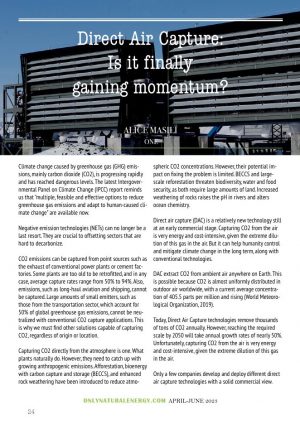 Climate change caused by greenhouse gas (GHG) emissions, mainly carbon dioxide (CO2), is progressing rapidly and has reached dangerous levels. The latest Intergovernmental Panel on Climate Change (IPCC) report reminds us that “multiple, feasible and effective options to reduce greenhouse gas emissions and adapt to human-caused climate change” are available now.
Climate change caused by greenhouse gas (GHG) emissions, mainly carbon dioxide (CO2), is progressing rapidly and has reached dangerous levels. The latest Intergovernmental Panel on Climate Change (IPCC) report reminds us that “multiple, feasible and effective options to reduce greenhouse gas emissions and adapt to human-caused climate change” are available now.
Negative emission technologies (NETs) can no longer be a last resort. They are crucial to offsetting sectors that are hard to decarbonize.
CO2 emissions can be captured from point sources such as the exhaust of conventional power plants or cement factories. Some plants are too old to be retrofitted, and in any case, average capture rates range from 50% to 94%. Also, emissions, such as long-haul aviation and shipping, cannot be captured. Large amounts of small emitters, such as those from the transportation sector, which account for 50% of global greenhouse gas emissions, cannot be neutralized with conventional CO2 capture applications. This is why we must find other solutions capable of capturing CO2, regardless of origin or location.
Capturing CO2 directly from the atmosphere is one. What plants naturally do. However, they need to catch up with growing anthropogenic emissions. Afforestation, bioenergy with carbon capture and storage (BECCS), and enhanced rock weathering have been introduced to reduce atmospheric CO2 concentrations. However, their potential impact on fixing the problem is limited. BECCS and large-scale reforestation threaten biodiversity, water and food security, as both require large amounts of land. Increased weathering of rocks raises the pH in rivers and alters ocean chemistry.
Direct air capture (DAC) is a relatively new technology still at an early commercial stage. Capturing CO2 from the air is very energy and cost-intensive, given the extreme dilution of this gas in the air. But it can help humanity control and mitigate climate change in the long term, along with conventional technologies.
DAC extract CO2 from ambient air anywhere on Earth. This is possible because CO2 is almost uniformly distributed in outdoor air worldwide, with a current average concentration of 405.5 parts per million and rising (World Meteorological Organization, 2019).
Today, Direct Air Capture technologies remove thousands of tons of CO2 annually. However, reaching the required scale by 2050 will take annual growth rates of nearly 50%. Unfortunately, capturing CO2 from the air is very energy and cost-intensive, given the extreme dilution of this gas in the air.
Only a few companies develop and deploy different direct air capture technologies with a solid commercial view.
Carbon Engineering is the first commercial company to pursue solvent DAC technology. The approach is based on a potassium hydroxide solvent combined with a calcium leach recovery loop. In 2015, Carbon Engineering built the first pilot-scale DAC plant in Canada. Between 2019 and 2021, a demonstration plant in Canada was designed and built.
Carbon Engineering plans to work with Oxy Low Carbon Ventures to finalize design plans for a plant in the Permian Basin. This project would capture and store up to 1 million tons of CO2 annually. In addition, Carbon Engineering is working with Pale Blue Dot in the United Kingdom.
Global Thermostat (GT) is a company based in the United States. Founded in 2010, GT currently has two DAC pilot plants with the potential to capture 3000-4000 tons of CO2 per year. Global Thermostat has partnered with ExxonMobil to develop its technology into a plant capable of capturing one million tons of CO2 annually.
Their process focuses on using process heat to regenerate the sorbent after capture. The capture process is followed by a CO2 capture system for various potential applications: reliable geological sequestration, biofuels, or non-combustible products such as fertilizers or building materials.
Climeworks was founded in Switzerland in 2009 and developed the first working prototype of its DAC technology in 2013. Climeworks’ technology is based on an adsorption/desorption process on alkaline functionalized adsorbents. Depending on environmental conditions, especially relative humidity, the current process can also recover H2O as a by-product from the air. In 2017, the first commercial DAC plant kicked off. Two years later, Climeworks opened its first carbon removal service for individual customers. The Suisse company has publicly set a goal of removing 225 million metric tons of CO2 from the atmosphere by 2025, or about 1% of total global emissions.
The first and largest direct airborne carbon capture and storage facility started operation in 2021. Orca, as it is called, consists of eight collection tanks, each with an annual intake capacity of 500 tons. The Hellisheidi geothermal power plant in Iceland supplies the required heat and electricity.
CarbonCapture Inc is an American company that plans to build an air pollution control plant. Project Bison will be the world’s largest carbon dioxide removal facility, aiming to remove 5 million tons of CO2 from the atmosphere annually by 2030, surpassing Iceland’s Orca facility.
Project Bison is being developed in Wyoming, which produces the most significant amount of CO2 nationwide due to the coal-fired power plants’ emissions.
When atmospheric capture begins in late 2023, the CO2 will be injected into wells for permanent storage in deep saline aquifers.
Alice Masili


